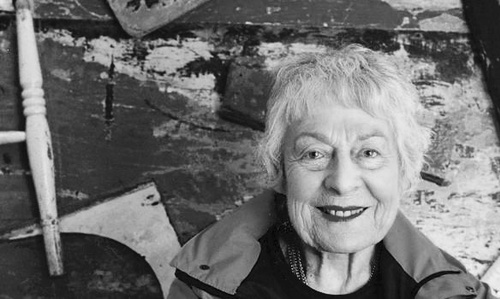Margaret Mellis was one of the early members, and last survivors, of the group of modernists that popularised St Ives as a hub of artistic activity in the 1940s.
Mellis was born in Wukingfu, Swatow, China, where her father was a missionary. Her family returned to East Lothian when she was one year old, shortly after the First World War broke out, so her father David Barclay Mellis-Smith could join up.
Abandoning an initial interest in music, she studied at Edinburgh College of Art from 1930 to 1934, under colourist Samuel John Peploe and landscape painters William Gillies and John Maxwell, alongside Wilhelmina Barns-Graham and William Gear. She used a travel scholarship to study with André Lhote in Paris. She met art critic Adrian Stokes in 1936 and they married in 1938. They visited Ezra Pound in Italy during their honeymoon and returned to London, where she studied at the Euston Road School.
Looking for a refuge from London before the Second World War broke out, Mellis and Stokes moved to Carbis Bay, near St Ives, in 1939. The couple's move to Cornwall was to be a catalyst for the burgeoning modernist movement that was to become internationally renowned throughout the middle of the twentieth century. They were soon joined by their friends Ben Nicholson and Barbara Hepworth, and Naum Gabo and his wife Miriam, and then subsequently Margaret's college friend Wilhelmina Barns-Graham. Margaret was encouraged to paint small abstract works, and to produce intricate collage. She was inspired by naive painter Alfred Wallis. Other visitors included Victor Pasmore, Graham Sutherland, William Coldstream, Julian Trevelyan and Peter Lanyon, and later a second wave including Roger Hilton, Patrick Heron, Terry Frost and Bryan Wynter.
Mellis left the St Ives area in 1946 after the breakdown of her marriage. Mellis and Stokes divorced in 1946, and he subsequently married her younger sister Ann. Patrick Heron introduced Mellis to painter Francis Davison, also recently divorced; they married in 1948 and lived for two years in the run-down Château des Enfants on the Cap d'Antibes. They moved to Walberswick in 1950, later moving to a smallholding at Syleham, near Diss. After 25 years of relative isolation and self-sufficiency, broken occasionally by visiting artist friends, then moved to Southwold in 1976.
Mellis was renowned throughout her career as a colourist. While under the influence of Nicholson she began to work in relief and collage, most notably Collage with Red Triangle II (1940) which was initially a gift for Naum Gabo and is now in the collection of the Victoria and Albert Museum. The breakdown of her first marriage caused her to reject abstraction for a period, returning to representational painting. However, works from the mid-1950s moved away from direct representation, simplifying still life and landscapes to flattened areas of pure colour. By the 1970s work was almost totally abstract and focused on geometric shape and colour.
In 1980 Mellis started making constructions out of found pieces of driftwood, which was to become her central practice until the end of her career. Whilst still retaining elements of representation, these works were more closely concerned with the relationship between form and colour. During the 1990s, Mellis became an early mentor and friend to the YBA artist Damien Hirst.
She exhibited infrequently through much of her life, and Hirst considers that her work has been unduly neglected. A major exhibition was held at Newlyn Art Gallery in 2001, and in 2008 a documentary Margaret Mellis a Life in Colour was made to accompany a major retrospective exhibition of her work at the Sainsbury Centre for Visual Arts, Norwich. In 2011 her work featured as a major part of the Tate St Ives Summer Exhibition, alongside Martin Creed and Agnes Martin. Her work is featured in major collections such as the Tate Gallery, the Victoria and Albert Museum, the Arts Council Collection, The Fleming Collection, City Art Centre, Edinburgh and the National Galleries of Scotland.
